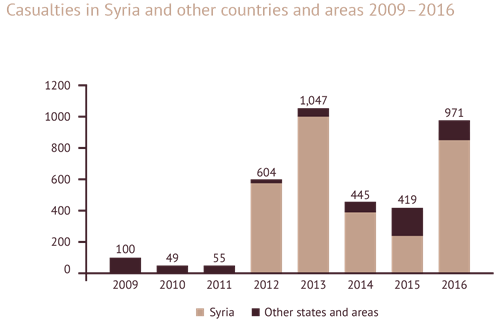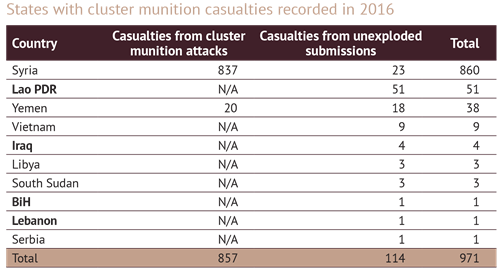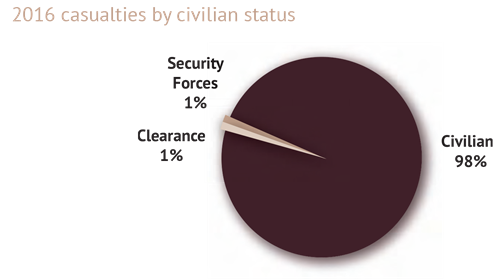Cluster Munition Monitor 2017
Casualties Munition Casualties
A total of 971 new cluster munition casualties were identified by the Monitor in 2016, but it is certain that this number does not capture all actual casualties and therefore the real number is most likely higher. Casualties recorded occurred due to both attacks and unexploded cluster submunitions.
This is the second-highest annual figure since Cluster Munition Monitor began consolidated analysis of reported cluster munitions casualties in 2009. It is a significant increase being more than double the 419 new cluster munition casualties in 2015.
Overall, in 2016, 857 people were killed and injured directly due to cluster munition use in two countries (Syria and Yemen), while unexploded submunitions caused 114 casualties in 10 countries.
Cluster munition attacks in Syria caused 837 casualties in 2016, and were the primary reason behind the sharp overall annual global increase. A 10-year peak in unexploded submunition casualties recorded in Lao PDR, the most affected country in the world, also added to the 2016 increase. This is a stern reminder that unexploded submunitions continue to kill and injure civilians, particularly children, for years and decades after they were used.
All cluster munition casualties over time
The total number of cluster munition casualties for all time recorded by the Monitor reached 21,275 as of the end of 2016. This total includes both casualties directly resulting from cluster munition use in attacks, and casualties from cluster munition remnants.[1] Casualties directly caused by use have been grossly under-recorded, including among military personnel and direct participants in armed conflict. As many casualties still go unrecorded, a better indicator of the total number of casualties globally over time is roughly 56,000, calculated from various country estimates. Global estimates of cluster munition casualties range as high as 86,000 casualties or more, but some of those totals are based on extrapolations from limited data samples, which may not be representative of national averages or the actual number of casualties.[2]
The Monitor provides the most comprehensive statistics available on cluster munition casualties recorded annually over time, in individual countries, and aggregated globally. Data is drawn from the mid-1960s, when the United States (US) extensively used cluster munitions in Southeast Asia, through to the end of 2016. It covers casualties from unexploded submunitions and use as recorded in 33 countries and three other areas (see table below).
The present total of 21,275 cluster munition casualties is far greater than the 13,306 recorded cluster munition casualties identified before the signing of the Convention on Cluster Munitions in 2008.[3] The increase is in part due to additional casualties from the past being identified through data collection efforts since the adoption of the convention. However, alarmingly, some 3,690 new casualties were recorded in the period 2009–2016. In that same period, cluster munition casualties were recorded in 17 countries and three other areas: States Parties Afghanistan, Bosnia and Herzegovina (BiH), Chad, Croatia, Iraq, Lao PDR, and Lebanon; signatory state Democratic Republic of Congo (DRC); and states not party Cambodia, Libya, Serbia, South Sudan, Sudan, Syria, Ukraine, Vietnam, and Yemen; and three other areas Kosovo, Nagorno-Karabakh, and Western Sahara. Most of the casualties since 2009 occurred in Syria.

The vast majority (17,291) of all reported casualties to date were from cluster munition remnants—typically explosive submunitions or bomblets that failed to detonate during strikes. Another 3,983 casualties occurred during the use of cluster munitions.[4]

Note: other areas are indicated in italics.[5]
A success of the Convention on Cluster Munitions has been increased awareness of and focus on the promise of ending the casualties and suffering caused by this indiscriminate weapon. Ultimately, that greater awareness has resulted in more and faster reporting of casualties during cluster munition use. Since 2014, casualties recorded from cluster munition strikes have outnumbered those from unexploded cluster submunitions.
Thousands of cluster munition casualties from past conflicts, particularly casualties that occurred during extensive use in Asia (including Southeast Asia and Afghanistan) and the Middle East (particularly Iraq), have gone unrecorded. The number of states with cluster munition victims is also likely to be greater than the 14 States Parties, 19 signatories, and three other areas currently identified.[6]
Casualties in 2016
A total of 971 cluster munition casualties were recorded by the Monitor in 2016, although this number does not capture all actual casualties and the real number is most likely higher. Cluster munition casualties were recorded in 10 countries.

Note: States Parties to the Convention on Cluster Munitions are indicated in bold; N/A = not applicable.
The 971 cluster munition casualties recorded in 2016 is more than twice the 419 casualties recorded for 2015, and the second-highest total since the beginning of Cluster Munition Monitor reporting for casualties in 2009. The total of cluster munition casualties in 2016 comes close to the highest annual casualty total reported during that period—1,047 casualties in 2013. The vast majority of recorded casualties in 2016 (89%) occurred in Syria.
Due to the lack of consistency in the availability and disaggregation of data on cluster munition casualties annually, comparisons with previous annual reporting are not believed to be necessarily indicative of definitive trends and specific fluctuations may be adjusted over time as new information becomes available.
Despite the increase in the global casualty total from 2015 to 2016, it is certain that the actual number of casualties occurring annually continues to be significantly under-reported. Several countries where casualties were reported do not have national casualty surveillance systems and also experienced ongoing or intensified conflict throughout 2016, which severely hampered data collection: Iraq, Libya, South Sudan, Syria, and Yemen.
Casualty demographics
In 2016, civilians made up 98% (694) of all cluster munition casualties for which the status was known (707). The status was unknown for 264 casualties. The high percentage of civilian casualties is consistent with findings based on analysis of historical data. Six casualties were recorded as military/combatants, and seven were clearance personnel (humanitarian deminers, explosive ordinance disposal technicians, or similar), making up some 1% of the 2016 total each.

Children[7] accounted for 41% of all cluster munition casualties, where the age group was reported in 2016. This included 175 children among 425 casualties of known age group.

Women and girls made up 27% of casualties, where sex was recorded (301).

Country details
Casualties from cluster munition use were recorded in two countries in 2016: Syria and Yemen. Casualties from unexploded submunitions were also reported in both states. In Syria, 837 casualties of cluster munition use and 23 casualties of unexploded submunitions were reported. An additional 83 casualties occurred when cluster munitions were used in conjunction with other weapons, and it is not possible to determine how many casualties were due to cluster munitions and how many to the other weapons.[8] Therefore, the Monitor has not included these casualties in the total figure. As has been the case each year since 2012, Syria had the highest annual total of reported cluster munition casualties.[9]
In Yemen, 38 cluster munition casualties were reported in 2016, which represented a decrease from the 104 casualties reported in 2015. The number of casualties reported as a result of cluster munition use decreased from 94 in 2015 to 20 in 2016, but the number of unexploded submunition casualties increased from 10 in 2015 to 18 in 2016.
In 2016, unexploded submunitions continued to result in casualties, both in countries that remain affected long after the munitions were used, and from the remnants of recent use in Syria and Yemen. Regardless of the time period since use, unexploded submunitions disproportionately harm civilians, including children. Unexploded submunition casualties were reported in 10 countries in 2016.
In Lao PDR, the number of submunition casualties increased from 18 recorded in 2015 to 51 recorded in 2016, marking a 10-year peak in unexploded cluster submunition casualties in the world’s most affected state. Of these, 67% (34) were children. In contrast, however, Lebanon experienced a significant drop in cluster munition casualties; only one submunition casualty was reported in 2016, many fewer than the 13 reported in 2015.
For the first time since 2009, Cambodia, a state not party to the Convention on Cluster Munitions, did not report any cluster munition casualties in 2016. No cluster munition casualties were identified in Ukraine in 2016, however data indicated that some records of unexploded submunition casualties contained insufficient detail to confirm the date of the incident.
Casualty recording
In most countries, the majority of cluster munition casualties were reported by mine action centers and clearance operators.
However, in Syria and Yemen, cluster munition casualties were mainly identified in information recorded by national and international civil society and NGOs, as well as through media reports. For Syria, these organizations were Human Rights Watch, the MayDay Rescue/Syria Civil Defence, the Syrian Network for Human Rights, and the Violations Documentation Center (VDC).[10] For Yemen, they were Amnesty International and Human Rights Watch. These organizations conducted field research to collect and verify reports of cluster munitions attacks and casualties. In the absence of national casualty surveillance systems, this important work by civil society organizations has captured data on the casualties and impact of cluster munitions that would have otherwise not been available. Several organizations focused their research specifically on cluster munitions in order to inform work undertaken in the context of the Convention on Cluster Munitions.
[1] Cluster munition remnants include abandoned cluster munitions, unexploded submunitions, and unexploded bomblets, as well as failed cluster munitions. Unexploded submunitions are “explosive submunitions” that have been dispersed or released from a cluster munition but failed to explode as intended. Unexploded bomblets are similar to unexploded submunitions but refer to “explosive bomblets,” which have been dispersed or released from an affixed aircraft dispenser and failed to explode as intended. Abandoned cluster munitions are unused explosive submunitions or whole cluster munitions that have been left behind or dumped and are no longer under the control of the party that left them behind or dumped them. See, Convention on Cluster Munitions, Art. 2 (5), (6), (7), and (15).
[2] See also, Handicap International (HI), Circle of Impact: The Fatal Footprint of Cluster Munitions on People and Communities (Brussels: HI, May 2007), bit.ly/MonitorHICircleofImpact2007. “A conservative estimate indicates that there are at least 55,000 cluster submunitions casualties but this figure could be as high as 100,000 cluster submunitions casualties.”
[3] The Monitor collects data from an array of sources, including national reports, mine action centers, mine clearance operators, and victim assistance service providers, as well as from a range of national and international media. Global cluster munition casualty data used by the Monitor includes the global casualty data collected by HI in 2006 and 2007. For the 13,306 cluster munition casualties reported for all time in 2007 see, HI, Circle of Impact: The Fatal Footprint of Cluster Munitions on People and Communities (Brussels: HI, May 2007), bit.ly/MonitorHICircleofImpact2007.
[4] Use includes casualties due to both ground-launched and air-deployed cluster munitions. Use occurs primarily during attacks or “strikes,” but also during the dumping of cluster munitions prior to aircraft landing. In addition, for one casualty it was not specified whether the casualty was due to use or unexploded submunitions. Monitor revision of past data has resulted in casualties that were thought to be, but not specifically labelled as unexploded submunition casualties, being recorded as cluster munition remnant casualties in global data.
[5] No precise number, or estimate, of casualties is known for Guinea-Bissau, Mozambique, or Somalia. In addition, there are known to be states, including States Parties to the Convention on Cluster Munitions, with cluster munition victims, including persons who were injured on the territory of other states.
[6] It is possible that cluster munition casualties have occurred but gone unrecorded in other countries where cluster munitions were used, abandoned, or stored in the past—such as States Parties Mauritania and Zambia, and non-signatories Azerbaijan, Iran, Saudi Arabia, and Zimbabwe. Better identification and disaggregation of cluster munition casualties are needed in most cluster munition-affected states and areas. States Parties Mauritania and Zambia have both reported that survey is required to identify if they have cluster munition victims on their territories. There is also a firsthand historical account of civilian casualties from an incident with an unexploded submunition at a weapons testing range in Zimbabwe, a non-signatory (in the time of the former Rhodesia). For the first time in 2015, Chad—a State Party reported to have cluster munition casualties earlier, but lacking disaggregated casualty data—recorded a specific unexploded submunition incident causing casualties. In Angola, a national victim survey identified at least 354 cluster munition survivors in one province. However, since Cluster Munition Monitor 2015 was published, newly available information has indicated uncertainty around this finding, both whether the casualties were caused by unexploded submunitions and the means by which they were identified. Pending further clarification, they remain in the Cluster Munition Monitor global casualty total.
[7] “Children” means persons under 18 years old, or those casualties listed as “child” in existing data or reporting.
[8] On 11 July 2016, three aircraft carried out multiple bombings near Termanin, a village in Idlib province, killing at least 10 people and injuring more than 30, all civilians. The bombings involved the use of cluster munitions and other weapons. See, Human Rights Watch (HRW), “Russia/Syria: Widespread New Cluster Munition Use,” 28 July 2016, bit.ly/HRWRussiaSyriaNewCMUse. The Syria Civil Defence reported four incidents in 2016 where cluster munitions use occurred along with other weapons used, resulting in 43 casualties. MayDay Rescue, “White Helmets [Syria Civil Defence] Daily Responses Report,” for the period October 2016 through December 2016.
[9] For Syria, 248 cluster munition casualties were reported in 2015; 383 in 2014; 1,001 in 2013; and at least 583 in 2012. The extreme difficulties faced in collecting data continued, which likely resulted in, an underreporting of cluster munition casualties in all years.
[10] SNHR, “Russian Forces are worse than the Syrian Regime in terms of cluster munition use,” 23 March 2017, sn4hr.org/blog/2017/03/24/36449/; HRW, “Russia/Syria: Widespread New Cluster Munition Use,” 28 July 2016; HRW, “Syria: Improvised Mines Kill, Injure Hundreds in Manbij,” 26 October 2016, bit.ly/SyriaImprovMinesManbij; VDC website, vdc-sy.net/en/; and MayDay Rescue, “White Helmets [Syrian Civil Defence] Daily Responses Report,” for the period October 2016 through December 2016.

